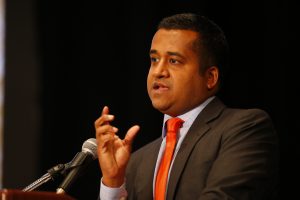Ohio explores perspectives, opportunities for modernizing the electric grid

This post was updated on June 20, 2017.
Just think about the number of interactions we have with electricity each day – from our alarm clocks to our toasters to our smart phones and the lights in our homes and offices.
Electricity is undeniably important to our lives and our economy. And unprecedented energy innovation has created the opportunity to build a smarter, cleaner, and more modern electric grid. But modernizing the grid won’t happen on its own.
That’s why The Nature Conservancy and Environmental Defense Fund (EDF) convened about a hundred participants for a grid modernization conference last week in Columbus, Ohio. People came together to discuss challenges with our aging and frayed grid as well as opportunities presented by modern sensors and smart meters. Although participants brought different perspectives, everyone agreed now is a critical, opportune time to upgrade our aging electric grid.
Special guests
The chairman of the Public Utilities Commission of Ohio (PUCO), Asim Haque, discussed his agency’s PowerForward initiative that will include a series of workshops about emerging smart-grid technologies and opportunities. Haque said the PUCO effort is based on two core concepts – encouraging energy innovation in Ohio and empowering and enriching the state’s customers.
The Ohio Senate president, Larry Obhof, expressed his interest in developing comprehensive and long-lasting energy policies that would attract investment and innovation in the state. The senator was particularly critical of persistent changes and uncertainties associated with the state’s efficiency and renewable energy standards.
Support from key decision makers, like at the PUCO and Ohio Legislature, will be critical to rewriting outdated rules that prevent progress.
An aging system
Electricity powers our everyday lives, and modernizing the electric grid is important because our current system is old and frayed. On any given day, half a million Americans lose power for two or more hours, and those disruptions cost our economy billions of dollars every year.
Moreover, 70 percent of the U.S. grid that delivers electricity to homes and businesses is at least 25 years old and unreliable, particularly compared with systems in every other developed nation: The U.S. suffers up to 214 minutes of outages each year depending on location, compared with just 15 for Germany and 4 for Japan. Without a more modern and smarter electric grid, the United States – including Ohio – is at a competitive disadvantage.
Opportunities
Grid modernization also is important because there are enormous opportunities to make our current system cleaner, smarter, and more efficient. In fact, there’s a technological revolution associated with sensors, meters, and controls that allows us to reimagine how we generate and deliver power.
For example, new technology provides enormous quantities of energy data, which can empower customers to have greater control over their energy use and electricity bills. It can also enable clean energy entrepreneurs to design new products and services that help customers save money and lower pollution. Forum participants concluded data was key to a smart, modern grid.
Those at the conference admitted that “grid modernization” can mean different things to different stakeholders. They generally agreed, however, that its achievement would be incremental rather than revolutionary. To EDF, a modern grid will reward customers, cleantech entrepreneurs, and power companies for making the nation’s electricity system more reliable, affordable, and clean. EDF will continue to bring different groups together to ensure we achieve a modern grid, one incremental step at a time.
Photo source: The Nature Conservancy.











One Comment
Dick, once again EDF makes inverifiable claims (in this case, about our “frayed grid”) with pseudo-references to its own website. I’m not surprised, nor am I surprised the venture capitalists who attended your conference agreed that “now is a critical, opportune time to upgrade our aging electric grid.” The key word, of course, is “opportune” – implying free-market investment will make our grid shiny and new; that adding more pieces to this already-hypercomplex puzzle will, counterintuitively, help to make reliable, inexpensive electricity available to all Americans.
Not regular maintenance, which in the past has served it so well?
Power engineers – the people who know how the grid works and why it’s breaking down – disagree. In fact, before the 2005 repeal of the Public Utility Holding Company Act deregulated the power industry, they warned profiteers would accelerate the breakdown of the U.S. grid. They were ignored, and they were right.
“Deregulation and the concomitant restructuring of the electric power industry has led to a shift from long term optimization, inter-system coordination and reliability towards dependence on immediate profits. In addition, there have been significant reductions in personnel at electric power organizations and companies, as well as increasing complexity in operations. Increased complexity has resulted in a dilution of management responsibility, as well as over-reliance on markets to solve scientifically complex problems.”
https://inis.iaea.org/search/search.aspx?orig_q=RN:37000028